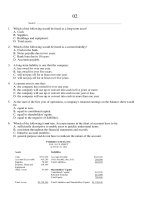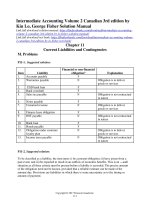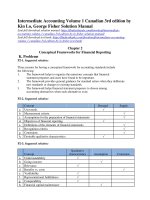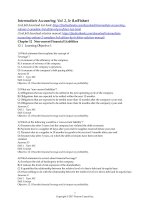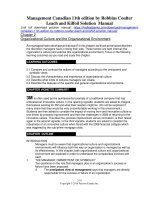International financial management canadian perspective canadian 3rd edition by brean eun resnick test bank
Bạn đang xem bản rút gọn của tài liệu. Xem và tải ngay bản đầy đủ của tài liệu tại đây (163.3 KB, 9 trang )
International Financial Management Canadian Perspective Canadian 3rd
edition by Don Brean Professor, Cheol Eun, Bruce G. Resnick Test Bank
Link full download test bank: />Link full download solution manual: />
2
KEY
1. The international monetary system can be defined as the institutional framework within which:
A.
B.
C.
D.
domestic payments are made
movements of goods are accommodated
interest rates of countries are determined
exchange rates among currencies are determined
Accessibility: Keyboard Navigation
Brean - Chapter 02 #1
Difficulty: Medium
Learning Objective: Introduction to International Monetary System
2. The international monetary system went through several distinct stages of evolution. These stages
are summarized, in alphabetic order, as follows:
(i)- Bimetallism
(ii)- Bretton Woods system (iii)Classical gold standard (iv)Flexible exchange rate regime
(v)- Interwar period
The (chronological) order that they actually occurred is:
A.
B.
C.
D.
(iii), (i), (iv), (ii), and (v)
(i), (iii), (v), (ii), and (iv)
(vi), (i), (iii), (ii), and (v)
(v), (ii), (i), (iii), and (iv)
Accessibility: Keyboard Navigation
Brean - Chapter 02 #2
Difficulty: Medium
Learning Objective: Evolution of the International Monetary System
3. An "international" gold standard can be said to exist when
A.
B.
C.
D.
both gold and silver is assured of unrestricted coinage
there is absolutely no convertibility between gold and national currencies at a stable ratio
gold may not be freely exported or imported
gold alone is assured of unrestricted coinage
Accessibility: Keyboard Navigation
Brean - Chapter 02 #3
Difficulty: Medium
Learning Objective: Classical Gold Standard: 1875-1914
4.
A.
B.
C.
D.
Which international organization was created by the Bretton Woods agreement:
WTO
World Bank
IMF
NAFTA
Accessibility: Keyboard Navigation
Brean - Chapter 02 #4
Difficulty: Easy
Learning Objective: Bretton Woods system: 1945-1972
5. Under the Bretton Woods system,
A. there was an explicit set of rules about the conduct of international trade policies
B. each country was responsible for maintaining its exchange rate within 2.50 percent of the adopted
par value by buying or selling foreign exchanges as necessary
C. the U.K. sterling pound was the only currency that was fully convertible to gold
D. each country established a par value in relation to the U.S. dollar, which was pegged to gold at
$35 per ounce.
Accessibility: Keyboard Navigation
Brean - Chapter 02 #5
Difficulty: Medium
Learning Objective: Bretton Woods system: 1945-1972
6. Gresham's law is most applicable to which of the following monetary system?
A.
B.
C.
D.
Bimetallism
Classical Gold Standard
Bretton Woods System
Flexible exchange rate regime
Accessibility: Keyboard Navigation
Brean - Chapter 02 #6
Difficulty: Medium
Learning Objective: Bimetallism: Before 1875.
7. On January 1, 1999, an epochal event took place in the arena of international finance when
A.
B.
C.
D.
all EU countries adopted a common currency called the euro.
eight of 15 EU countries adopted a common currency called the euro.
nine of 15 EU countries adopted a common currency called the euro.
eleven of 15 EU countries adopted a common currency called the euro.
Accessibility: Keyboard Navigation
Brean - Chapter 02 #7
Difficulty: Medium
Learning Objective: The European Monetary System
8. The exchange rate arrangement in which the currency is adjusted periodically in small amounts at
a fixed, preannounced rate or in response to changes in selective quantitative indicators is called
A.
B.
C.
D.
Currency Board
Pegged Exchange rate within horizontal bands
Crawling pegs
Exchange rate within crawling bands
Accessibility: Keyboard Navigation
Brean - Chapter 02 #8
Difficulty: Medium
Learning Objective: The Current Exchange Rate Arrangement
9. Special Drawing Rights (SDR) is:
A. used to make international payments to non-member of the International Monetary Fund (IMF).
B. a "portfolio" of currencies, and its value tends to be more instable than the currencies that it
is comprised of.
C. used in addition to gold and foreign exchanges, to make domestic payments.
D. a basket currency comprising major individual currencies allotted to the members of the IMF,
who could then use SDRs for transactions among themselves or with IMF.
Accessibility: Keyboard Navigation
Brean - Chapter 02 #9
Difficulty: Easy
Learning Objective: Bretton Woods system: 1945-1972
10. Which of the following objectives is not true regarding European Monetary System (EMS):
A.
B.
C.
D.
To establish a "zone of monetary stability" in Europe
To coordinate exchange rate policies vis-à-vis the non EMS currencies
To pave the way for the eventual European monetary union
To pave away from the European monetary union
Accessibility: Keyboard Navigation
Brean - Chapter 02 #10
Difficulty: Medium
Learning Objective: European Monetary System
11. A key element of the Jamaica Agreement from 1976 is
A.
B.
C.
D.
fixed exchange rates were declared unacceptable to the IMF members
pegged exchange rates were declared unacceptable to the IMF members
flexible exchange rates were declared acceptable to the IMF members
mixed exchange rates were declared acceptable to the IMF members
Accessibility: Keyboard Navigation
Brean - Chapter 02 #11
Difficulty: Medium
Learning Objective: The Flexible Exchange Rate Regime: 1973-Present
12. A "good" (or ideal) international monetary system should provide:
A.
B.
C.
D.
liquidity, elasticity, and flexibility
elasticity, sensitivity, and reliability
liquidity, adjustments, and confidence
sensitivity, elasticity, and flexibility
Accessibility: Keyboard Navigation
Brean - Chapter 02 #12
Difficulty: Hard
Learning Objective: Fixed versus Flexible Exchange Rate Regimes
13. Suppose that the British pound is pegged to gold at £6 per ounce, whereas one ounce of gold is
worth FF12. Under the gold standard, any misalignment of the exchange rate will be automatically
corrected by cross border flows of gold. Calculate the possible savings for buying FF1,000, if the
British pound becomes undervalued and trades for FF1.80/£. (Assume zero shipping costs).
(Hint: Gold is first purchased using the devalued British pound from the Bank of England,
then shipped to France and sold for FF1,000 to the Bank of France).
A.
B.
C.
D.
£55.56
£65.56
£75.56
£85.56
FF12/£6 = FF2/£1, therefore
FF1,000/2 = £500.00
FF1,000/£1.80 = £555.56
Savings = £555.56 - £500.00
= £55.56
Accessibility: Keyboard Navigation
Brean - Chapter 02 #13
Difficulty: Hard
Learning Objective: Classical Gold Standard: 1875-1914
14. Which of the following is NOT a benefit of a monetary union?
A.
B.
C.
D.
Elimination of exchange rate uncertainty
Reduced transactions costs
Ability to absorb asymmetric economic shocks
Enhanced efficiency and competitiveness
Accessibility: Keyboard Navigation
Brean - Chapter 02 #14
Difficulty: Hard
Learning Objective: The Euro and the European Monetary Union
15. Which of the following is a cost of a Monetary Union:
A.
B.
C.
D.
Loss of national monetary policy independence
Loss of exchange rate uncertainty
Increased transaction costs
Loss of efficiency
Accessibility: Keyboard Navigation
Brean - Chapter 02 #15
Difficulty: Hard
Learning Objective: The Euro and the European Monetary Union
16. Which is the following is true for countries with fixed exchange rate regimes?
A. Central banks of these courtiers are required to maintain exchange reserves to cover 100% of
the existing domestic currency
B. Centrals banks cannot use monetary policy to affect the economic fundamentals (such as inflation)
C. These countries must use currency board
D. The external value of the country's currency will simply depreciate to the level at which there is
no excess supply of the country's currency
Accessibility: Keyboard Navigation
Brean - Chapter 02 #16
Difficulty: Medium
Learning Objective: The Current Exchange Rate Arrangement
17. If, under the Gold Standard, the price of 1oz of gold was $15 or £5, what was the $/£ exchange rate?
A.
B.
C.
D.
$0.25/£
$0.33/£
$1/£
$3/£
Accessibility: Keyboard Navigation
Brean - Chapter 02 #17
Difficulty: Easy
Learning Objective: Classical Gold Standard: 1875-1914
18. The key arguments for flexible exchange rates are:
A.
B.
C.
D.
Easier external adjustments and national policy autonomy
Easier internal adjustments and national policy autonomy
Easier external adjustments and easier international trade
Easier internal adjustments and easier international trade
Accessibility: Keyboard Navigation
Brean - Chapter 02 #18
Difficulty: Medium
Learning Objective: Fixed versus Flexible Exchange Rate Regimes
19. Which of the following is NOT a responsibility of the European System of Central Banks:
A.
B.
C.
D.
To define and implement the common monetary policy of the EU
To define and implement the common fiscal policy of the EU
To conduct foreign exchange operations
To hold and manage the official foreign exchange reserves of the euro member states
Accessibility: Keyboard Navigation
Brean - Chapter 02 #19
Difficulty: Easy
Learning Objective: The Euro and the European Monetary Union
20. Comparing the Euro-17 and the United States, which of the following statements is true?
A.
B.
C.
D.
The United States has a larger population than the Euro-17.
The United States has a larger GDP than the Euro-17.
Euro -17 has a larger share of World Trade than the United States.
Euro -17 has less international bonds outstanding than the United States.
Accessibility: Keyboard Navigation
Brean - Chapter 02 #20
Difficulty: Medium
Learning Objective: The Euro and the European Monetary Union
21. Bretton Woods system:
A.
B.
C.
D.
is an example of a fixed exchange rate regime
is an example of a flexible exchange rate regime
gave birth to the introduction of the Euro
was used to smooth transition from bimetallism to the classical gold standard
Accessibility: Keyboard Navigation
Brean - Chapter 02 #21
Difficulty: Medium
Learning Objective: Bretton Woods system: 1945-1972
22. Before World War I, $20.67 was needed to buy one ounce of gold and FF 310.00 would also buy
one ounce of gold. What was the exchange rate between the French franc and the US dollar?
A.
B.
C.
D.
FF0.0667/$
FF14.9976/$
FF6407.7/$
$6407.7/FF
FF310/$20.67 = FF 14.9976/$
Accessibility: Keyboard Navigation
Brean - Chapter 02 #22
Difficulty: Easy
Learning Objective: Classical Gold Standard: 1875-1914
23. It is said that the gold-exchange system was programmed to collapse in the long run. To satisfy
the growing need for reserves, the United States had to run balance-of-payments deficits
continuously. Yet, if the United States ran perennial balance-of-payments deficits, it would
eventually impair the public confidence in the dollar. This dilemma was known as the
A.
B.
C.
D.
Triffin paradox
Triffin dilemma
Mundell paradox
Mundell dilemma
Accessibility: Keyboard Navigation
Brean - Chapter 02 #23
Difficulty: Easy
Learning Objective: Bretton Woods system: 1945-1972
24. Before World War I, GBP 2.2474 was needed to buy one ounce of gold. FF 310.00 would also buy
one ounce of gold. What was the exchange rate between the French franc and the British Pound?
FF310/GBP2.2474 = FF137.9372/GBP
Brean - Chapter 02 #24
Learning Objective: Classical Gold Standard: 1875-1914
25. Suppose that the British pound is pegged to gold at £6 per ounce and one ounce of gold is
worth FF12. The exchange rate is FF1.8/£ and you have FF11, 000. How much profit can you
make? (Assume zero shipping costs).
Exchange FF to £ at current exchange rate: FF11,000/(FF1.8/£) =
£6,111 then use £ to buy gold £6,111/(£6/ounce) = 1,018.52 ounces,
sell the gold for FF 1,018.52ounces*FF12/ounce =
FF12,222.22 profit: FF12,222.22 - FF11,000 = FF1,222.22
Brean - Chapter 02 #25
Learning Objective: Classical Gold Standard: 1875-1914
26. The Argentine peso was pegged to the US dollar at a rate of 1 to 1 until January 17, 2002.
Argentina experienced trade deficits in prior to the collapse of the currency board. Graphically
illustrate the external adjustment mechanism.
Brean - Chapter 02 #26
Learning Objective: Fixed versus Flexible Exchange Rate Regimes
27. Can all of the following three conditions:
(1) fixed exchange rate,
(2) free international flow of capital, and
(3) independent monetary policy
Be satisfied simultaneously? Why?
A country can attain only two of these three conditions. If a country would like to maintain a fixed
exchange rate (which is considered beneficial for international trade) and an independent monetary
policy (to pursue its own domestic economic goals), it needs to restrict the international flow of capital.
If the country does allow also free international flow of capital, the country's currency is subject to
speculative attacks and currency crises.
Brean - Chapter 02 #27
Learning Objective: Fixed versus Flexible Exchange Rate Regimes
28. The Chinese renminbi is currently pegged to the US dollar at a rate of 8.28 to 1. The renminbi is
considered to be undervalued (that is the exchange rate should be lower). Graphically illustrate
the external adjustment mechanism. What happens to the Chinese foreign exchange reserves?
At an exchange rate of renminbi 8.28/$, there will be an excess supply of the dollar which the
Chinese government can buy up. Therefore, the Chinese foreign exchange reserves are increasing.
Brean - Chapter 02 #28
Learning Objective: Fixed versus Flexible Exchange Rate Regimes
02 Summary
Category
# of Questions
Accessibility: Keyboard Navigation
Brean - Chapter 02
Difficulty: Easy
Difficulty: Hard
Difficulty: Medium
Learning Objective: Bimetallism: Before 1875.
Learning Objective: Bretton Woods system: 1945-1972
Learning Objective: Classical Gold Standard: 1875-1914
Learning Objective: European Monetary System
Learning Objective: Evolution of the International Monetary System
Learning Objective: Fixed versus Flexible Exchange Rate Regimes
Learning Objective: Introduction to International Monetary System
Learning Objective: The Current Exchange Rate Arrangement
Learning Objective: The Euro and the European Monetary Union
Learning Objective: The European Monetary System
Learning Objective: The Flexible Exchange Rate Regime: 1973-Present
23
28
6
4
13
1
5
6
1
1
5
1
2
4
1
1
